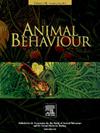Galápagos yellow warblers differ in behavioural plasticity in response to traffic noise depending on proximity to road
IF 2.3
2区 生物学
Q2 BEHAVIORAL SCIENCES
引用次数: 0
Abstract
Acoustic communication between animals is increasingly disrupted by noise in human-altered environments making signals less effective. Birdsong is a signal used in agonistic interactions between territorial rivals, and birds may modify their song and singing behaviour in response to noise. However, if these modifications are still ineffective, this can lead to increased conflict between rivals. Here, we asked whether experimental traffic noise induces immediate changes in acoustic characteristics of song and aggressive behaviour in populations and territories that differ greatly in traffic noise exposure. We conducted simulated territorial intrusions on Galápagos yellow warblers, Setophaga petechia aureola, living on Santa Cruz (high traffic) and Floreana (low traffic) islands. Territories were either adjacent to the nearest road or at least 100 m away from it. We assessed the focal birds’ physical response levels and recorded their vocalizations in response to the playback of conspecific song (control) and conspecific song coupled with traffic noise (noise treatment). We found that, on both islands, birds living in territories adjacent to roads increased their aggression levels with experimental noise compared to control, while birds living farther away from roads decreased their aggression levels. Birds on both islands increased minimum frequency of their songs during the noise treatment, irrespective of their distance to a road. However, changes in peak frequency and duration of their songs depended on the habitat they live in. Our results suggest behavioural flexibility in territorial responses and birdsong in response to traffic noise, which appears to depend at least in part on prior experience with traffic noise.
Galápagos黄莺对交通噪音的行为可塑性因距离道路远近而异
在人为改变的环境中,动物之间的声音交流越来越多地受到噪音的干扰,使信号变得不那么有效。鸟鸣是一种用于领土竞争对手之间激烈互动的信号,鸟类可能会根据噪音改变它们的鸣叫行为。然而,如果这些修改仍然无效,这可能导致竞争对手之间的冲突增加。在这里,我们询问实验性交通噪音是否会在交通噪音暴露程度差异很大的人群和地区中引起歌曲和攻击行为的声学特征的立即变化。我们模拟了Galápagos黄莺的领土入侵,Setophaga petechia aureola,生活在圣克鲁斯岛(高流量)和弗洛里安娜岛(低流量)。领土要么与最近的道路相邻,要么至少距离道路100米。我们评估了焦点鸟的身体反应水平,并记录了它们对同种鸣声(对照)和同种鸣声与交通噪音(噪音处理)的反应。我们发现,在这两个岛屿上,与对照组相比,生活在靠近道路区域的鸟类在实验噪音下的攻击水平增加了,而远离道路的鸟类的攻击水平降低了。在噪音处理期间,两个岛上的鸟类的最低鸣叫频率都有所增加,与它们与道路的距离无关。然而,它们唱歌的峰值频率和持续时间的变化取决于它们所居住的栖息地。我们的研究结果表明,领土反应和鸟鸣对交通噪音的反应的行为灵活性,似乎至少部分取决于先前对交通噪音的经验。
本文章由计算机程序翻译,如有差异,请以英文原文为准。
求助全文
约1分钟内获得全文
求助全文
来源期刊

Animal Behaviour
生物-动物学
CiteScore
4.60
自引率
8.00%
发文量
236
审稿时长
10.2 weeks
期刊介绍:
Growing interest in behavioural biology and the international reputation of Animal Behaviour prompted an expansion to monthly publication in 1989. Animal Behaviour continues to be the journal of choice for biologists, ethologists, psychologists, physiologists, and veterinarians with an interest in the subject.
 求助内容:
求助内容: 应助结果提醒方式:
应助结果提醒方式:


